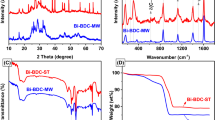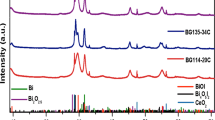Abstract
A series of alkaline earth metal stannates, MSnO3 (M2+ = Ca2+, Sr2+, Ba2+), has been synthesized by a microwave hydrothermal method and subsequent heat treatment process for the first time. The obtained samples are characterized by X-ray diffraction, Brunauer–Emmett–Teller (BET) surface area analysis, UV–Vis diffuse reflectance spectroscopy, scanning electron microscopy, and a photoluminescence technique with terephthalic acid. It is found that the variation of M2+ radius in MSnO3 leads to a change in the crystal structure and the photocatalytic degradation activity for methyl orange. With the increase of M2+ radius, dipole moments are generated in octahedral units because of the octahedral tilting distortion, which may facilitate the mobility of charge carriers and improve the activities of MSnO3. The wider band gap and larger BET surface area caused by the decrease of M2+ radius also contribute to photocatalytic performances. In addition, compared with the conventional hydrothermal method, higher activity is achieved on the samples prepared by means of the microwave method. Our findings may provide insights in fabrication of highly efficient photocatalysts by adjusting the counter-cation radius.











Similar content being viewed by others
References
Ma W, Li J, Tao X, He J, Xu Y, Yu JC, Zhao J (2003) Efficient degradation of organic pollutants by using dioxygen activated by resin-exchanged iron(II) bipyridine under visible irradiation. Angew Chem Int Ed 42:1029–1032
Chen X, Mao SS (2007) Titanium dioxide nanomaterials: synthesis, properties, modifications, and applications. Chem Rev 107:2891–2959
Xu C, Cui AJ, Yuan Y, Chen ZX, Yuan RS, Fu XZ (2013) Synthesis of visible-light-responsive Fe(III)-doped TiO2 films using graphene oxide-based composite sheets as sacrificial building blocks. J Mater Sci 48:3428–3435
Liu YB, Zhou BX, Bai J, Li JH, Zhang JL, Zheng Q, Zhu XY, Cai WM (2009) Efficient photochemical water splitting and organic pollutant degradation by highly ordered TiO2 nanopore arrays. Appl Catal B 89:142–148
Maeda K, Takata T, Hara M, Saito N, Inoue Y, Kobayashi H, Domen K (2005) GaN:ZnO solid solution as a photocatalyst for visible-light-driven overall water splitting. J Am Chem Soc 127:8286–8287
Su WY, Chen JX, Wu L, Wang XC, Wang XX, Fu XZ (2008) Visible light photocatalysis on praseodymium(III)-nitrate-modified TiO2 prepared by an ultrasound method. Appl Catal B 77:264–271
Wang WJ, Zhang LZ, An TC, Li GY, Yip HY, Wong PK (2011) Comparative study of visible-light-driven photocatalytic mechanisms of dye decolorization and bacterial disinfection by B-Ni-codoped TiO2 microspheres: the role of different reactive species. Appl Catal B 108–109:108–116
Liao GZ, Chen S, Quan X, Chen H, Zhang YB (2010) Photonic crystal coupled TiO2/polymer hybrid for efficient photocatalysis under visible light irradiation. Environ Sci Techol 44:3481–3485
Wojtoniszak M, Zielinska B, Chen XC, Kalenczuk RJ, Borowiak-Palen E (2012) Synthesis and photocatalytic performance of TiO2 nanospheres–graphene nanocomposite under visible and UV light irradiation. J Mater Sci 47:3185–3190
Liang S, Wu L, Bi J, Wang W, Gao J, Li Z, Fu X (2010) A novel solution-phase approach to nanocrystalline niobates: selective syntheses of Sr0.4H1.2Nb2O6·H2O nanopolyhedra and SrNb2O6 nanorods photocatalysts. Chem Commun 46:1446–1448
Liang S, Zhu S, Chen Y, Wu W, Wang X, Wu L (2012) Rapid template-free synthesis and photocatalytic performance of visible light-activated SnNb2O6 nanosheet. J Mater Chem 22:2670–2678
Liang S, Shen L, Zhu J, Zhang Y, Wang X, Li Z, Wu L, Fu X (2011) Morphology-controlled synthesis and efficient photocatalytic performances of a new promising photocatalyst Sr0.25H1.5Ta2O6·H2O. RSC Adv 1:458–467
Tang JW, Zou ZG, Ye JH (2003) Photophysical and photocatalytic properties of AgInW2O8. J Phys Chem B 107:14265–14269
Zhang C, Zhu YF (2005) Synthesis of square Bi2WO6 nanoplates as high-activity visible-light-driven photocatalysts. Chem Mater 17:3537–3545
Fu HB, Pan CS, Yao WQ, Zhu YF (2005) Visible-light-induced degradation of rhodamine B by nanosized Bi2WO6. J Phys Chem B 109:22432–22439
Azad AM, Shyan LLW, Alim MA (1999) Immittance response of CaSnO3 prepared by self-heat-sustained reaction. J Mater Sci 34:1175–1187
Cerdà J, Arbiol J, Dezanneau G, Díaz R, Morante JR (2002) Perovskite-type BaSnO3 powders for high temperature gas sensor applications. Sens Actuators B 84:21–25
Gopal-Reddy CV, Manorama SV, Rao VJ, Lobo A, Kulkarni SK (1999) Noble metal additive modulation of gas sensitivity of BaSnO3, explained by a work function based model. Thin Solid Films 348:261–265
Sharma N, Shaju KM, Subba-Rao GV, Chow-dari BV (2002) Sol–gel derived nano-crystalline CaSnO3 as high capacity anode material for Li-ion batteries. Electrochem Commun 4:947–952
Zhang WF, Tang JW, Ye JH (2007) Structural, photocatalytic, and photophysical properties of perovskite MSnO3 (M = Ca, Sr, and Ba) photocatalysts. J Mater Res 22:1859–1871
Wang WJ, Bi JH, Wu L, Li ZH, Fu XZ (2009) Hydrothermal synthesis and catalytic performances of a new photocatalyst CaSnO3 with microcube morphology. Scripta Mater 60:186–189
Zou ZG, Ye JH, Arakawa H (2001) Substitution effects of In3+ by Al3+ and Ga3+ on the photocatalytic and structural properties of the Bi2InNbO7 photocatalyst. Chem Mater 13:1765–1769
Xu AW, Gao Y, Liu HQ (2002) The preparation, characterization, and their photocatalytic activities of rare-earth-doped TiO2 nanoparticles. J Catal 207:151–157
Wang DH, Wang L, Xu AW (2012) Room-temperature synthesis of Zn0.80Cd0.20S solid solution with a high visible-light photocatalytic activity for hydrogen evolution. Nanoscale 4:2046–2053
Liang S, Zhu S, Zhu J, Chen Y, Zhang Y, Wu L (2012) The effect of group IIIA metal ion dopants on the photocatalytic activities of nanocrystalline Sr0.25H1.5Ta2O6·H2O. Phys Chem Chem Phys 14:1212–1222
Bi JH, Wu L, Zhang YF, Li ZH, Li JQ, Fu XZ (2009) Solvothermal preparation, electronic structure and photocatalytic properties of PbMoO4 and SrMoO4. Appl Catal B 91:135–143
Zou ZG, Ye JH, Arakawa H (2002) Role of R in Bi2RNbO7 (R = Y, Rare Earth): Effect on band structure and photocatalytic properties. J Phys Chem B 106:517–520
Sutton WH (1989) Microwave processing of ceramic materials. Am Ceram Soc Bull 68:376–386
Siores E, Dorego D (1995) Microwave applications in materials joining. J Mater Process Technol 48:619–625
Li WW, Zhao Y, Yuan S, Shi LY, Wang ZY, Fang JH, Zhang MH (2012) Synthesis and characterization of highly dispersed TiO2 nanocrystal colloids by microwave-assisted hydrothermal method. J Mater Sci 47:7999–8006
Tao Y, Wu C, Mazyck DW (2006) Microwave-assisted preparation of TiO2/activated carbon composite photocatalyst for removal of methanol in humid air streams. Ind Eng Chem Res 45:5110–5116
Zhang P, Yin S, Sato T (2009) Synthesis of high-activity TiO2 photocatalyst via environmentally friendly and novel microwave assisted hydrothermal process. Appl Catal B 89:118–122
Wu L, Bi JH, Li ZH, Wang XX, Fu XZ (2008) Rapid preparation of Bi2WO6 photocatalyst with nanosheet morphology via microwave-assisted solvothermal synthesis. Catal Today 131:15–20
Bi JH, Wu L, Li J, Li ZH, Wang XX, Fu XZ (2007) Simple solvothermal routes to synthesize nanocrystalline Bi2MoO6 photocatalysts with different morphologies. Acta Mater 55:4699–4705
Lu ZG, Liu JF, Tang YG, Li YD (2004) Hydrothermal synthesis of CaSnO3 cubes. Inorg Chem Commun 7:731–733
Payne MC, Teter MP, Allan DC, Arias TA, Joannopoulos JD (1992) Iterative minimization techniques for ab initio total-energy calculations: molecular dynamics and conjugate gradients. Rev Mod Phys 64:1045–1097
Vanderbilt D (1990) Soft self-consistent pseudopotentials in a generalized eigenvalue formalism. Phys Rev B 41:7892–7895
Ishibashi K, Fujishima A, Watanabe T, Hashimoto K (2000) Detection of active oxidative species in TiO2 photocatalysis using the fluorescence technique. Electrochem Commun 2(2000):207–210
Mizoguchi H, Eng HW, Woodward PM (2004) Probing the electronic structures of ternary perovskite and pyrochlore oxides containing Sn4+ or Sb5+. Inorg Chem 43:1667–1680
Chen D, Ye JH (2007) SrSnO3 nanostructures: synthesis, characterization, and photocatalytic properties. Chem Mater 19:4585–4591
Zhang WF, Tang JW, Ye JH (2006) Photoluminescence and photocatalytic properties of SrSnO3 perovskite. Chem Phys Lett 418:174–178
Yin S, Yamaki H, Komatsu M, Zhang Q, Wang J, Tang Q, Saito F, Sato T (2003) Preparation of nitrogen-doped titania with high visible light induced photocatalytic activity by mechanochemical reaction of titania and hexamethylenetetramine. J Mater Chem 13:2996–3001
Xiang Q, Yu J, Wong PK (2011) Quantitative characterization of hydroxyl radicals produced by various photocatalysts. J Colloid Interface Sci 357:163–167
Sato J, Kobayashi H, Inoue Y (2003) Photocatalytic activity for water decomposition of indates with octahedrally coordinated d10 configuration. II. roles of geometric and electronic structures. J Phys Chem B 107:7970–7975
Sato J, Saito S, Nishiyama H, Inoue Y (2003) Photocatalytic activity for water decomposition of indates with octahedrally coordinated d10 configuration. I. influences of preparation conditions on activity. J Phys Chem B 107:7965–7969
Sato J, Kobayashi H, Saito N, Nishiyama H, Inoue Y (2003) Photocatalytic activities for water decomposition of RuO2-loaded AInO2 (A = Li, Na) with d10 configuration. J Photochem Photobiol A 158:139–144
Kohno M, Ogura S, Sato K, Inoue Y (1997) Reduction and oxidation of BaTi4O9 with a pentagonal prism tunnel structure effects on radical formation upon UV irradiation and on the activity of RuO2/BaTi4O9 photocatalyst for water decomposition. J Chem Soc Faraday Trans 93:2433–2437
Xu Y, Schoonen MAA (2000) The absolute energy positions of conduction and valence bands of selected semiconducting minerals. Am Mineral 85:543–556
Komarneni S, Katsuki H (2002) Nanophase materials by a novel microwave-hydrothermal process. Pure Appl Chem 74:1537–1543
Apte SK, Garaje SN, Bolade RD, Ambekar JD, Kulkarni MV, Naik SD, Gosavi SW, Baeg JO, Kale BB (2010) Hierarchical nanostructures of CdIn2S4 via hydrothermal and microwave methods: efficient solar-light-driven photocatalysts. J Mater Chem 20:6095–6102
Acknowledgements
This work was supported by the National Natural Science Foundation of China (21003022, 21177024, 21273036, and 21303019) and the Natural Science Foundation of Fujian Province (2011J01041).
Author information
Authors and Affiliations
Corresponding author
Rights and permissions
About this article
Cite this article
Wang, W., Liang, S., Ding, K. et al. Microwave hydrothermal synthesis of MSnO3 (M2+ = Ca2+, Sr2+, Ba2+): effect of M2+ on crystal structure and photocatalytic properties. J Mater Sci 49, 1893–1902 (2014). https://doi.org/10.1007/s10853-013-7880-x
Received:
Accepted:
Published:
Issue Date:
DOI: https://doi.org/10.1007/s10853-013-7880-x




